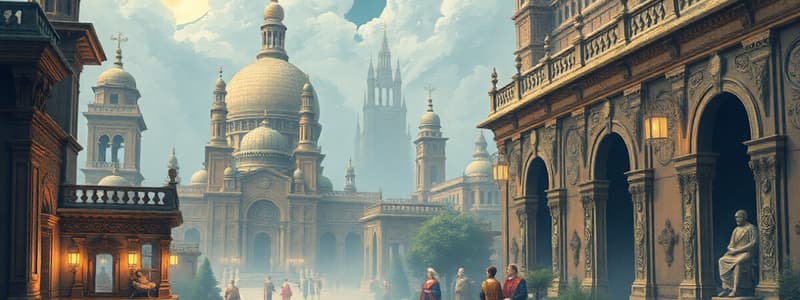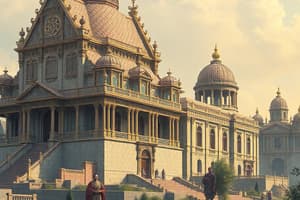Podcast
Questions and Answers
Which of the following are commonly studied in world history?
Which of the following are commonly studied in world history?
- Culinary arts and traditions
- Fashion trends over decades
- Wars and conflicts (correct)
- Music evolution across centuries
What is a key factor in the development of global connections throughout history?
What is a key factor in the development of global connections throughout history?
- The emergence of local festivals
- Trade routes and migration patterns (correct)
- Development of individual hobbies
- Invention of new sports activities
Which significant transformation marks the transition from agricultural societies to industrial societies?
Which significant transformation marks the transition from agricultural societies to industrial societies?
- The spread of culinary techniques
- The introduction of democracy
- The development of global economies (correct)
- The rise of local artisans
What type of advancements can be classified under scientific and technological innovations throughout history?
What type of advancements can be classified under scientific and technological innovations throughout history?
Which elements are critical to understanding the interplay of different cultures in history?
Which elements are critical to understanding the interplay of different cultures in history?
What characteristic is often associated with major political revolutions in history?
What characteristic is often associated with major political revolutions in history?
Which of the following best describes a major impact of colonialism on world history?
Which of the following best describes a major impact of colonialism on world history?
What aspect of historical study can help illustrate the sequence of significant events?
What aspect of historical study can help illustrate the sequence of significant events?
Flashcards
Major historical events
Major historical events
Significant occurrences in history, often affecting nations or societies.
Political revolutions
Political revolutions
Radical changes in government, often following widespread protests or conflicts.
Economic developments
Economic developments
Changes in trade, industry, and economic systems over time.
Religious movements
Religious movements
Signup and view all the flashcards
Geographical regions
Geographical regions
Signup and view all the flashcards
Cultural diffusion
Cultural diffusion
Signup and view all the flashcards
Colonialism
Colonialism
Signup and view all the flashcards
Transition to industrial societies
Transition to industrial societies
Signup and view all the flashcards
Study Notes
Chapter Nine: World History Overview
- Chapter 9 will likely cover a significant period of world history, potentially spanning centuries or millennia.
- The focus could include civilizations, major events, or historical trends.
- A precise outline is impossible without the full text.
Potential Topics Covered
- Major historical events, categorized chronologically:
- Wars and conflicts, focusing on causes, consequences, and key figures
- Political revolutions and societal transformations
- Economic developments and trade routes
- Religious movements and their impact
- Scientific advancements and technological innovations
- Geographical regions and cultures:
- Overviews of significant empires, kingdoms, or dynasties
- Examinations of cultural interactions and exchanges
- Descriptions of social structures and cultural practices
- Emphasis on important historical figures and events within the region.
- Global connections and interconnectedness:
- Exploration of trade routes, migration patterns, and cultural diffusion
- Discussion of the impacts of colonialism and imperialism
- Analysis of global conflicts and alliances
- Periods of significant change or advancement:
- The transition from agricultural societies to industrial societies
- The rise and fall of empires
- The development of global economies
Expected Content Structure
- Introduction to the time period or theme.
- Detailed information on various topics, timelines, and contexts.
- Analysis and interpretation of events, cultural shifts, and societal developments.
- Specific examples, case studies, and relevant details.
- Visual aids (maps, charts, images) to illustrate concepts and facts.
- Comparison and contrast of different civilizations, cultures, and societies.
- Synthesis of information from primary and secondary sources.
- Possible emphasis on key figures, influential movements, or notable moments.
Essential Considerations for Studying
- Take detailed notes, highlighting key terms, dates, and names.
- Create a timeline of important events to understand sequences.
- Compare and contrast different historical periods and events.
- Use maps to visualize geographical contexts of historical events.
- Connect information to broader course themes.
- Consider the perspectives of all involved groups and cultures.
Studying That Suits You
Use AI to generate personalized quizzes and flashcards to suit your learning preferences.




